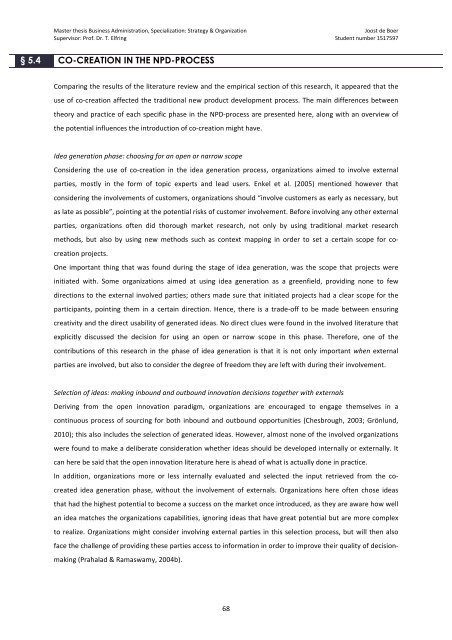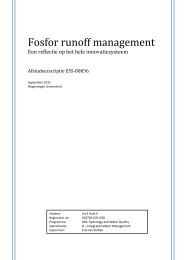Download PDF (English) - Future Ideas
Download PDF (English) - Future Ideas
Download PDF (English) - Future Ideas
You also want an ePaper? Increase the reach of your titles
YUMPU automatically turns print PDFs into web optimized ePapers that Google loves.
Master thesis Business Administration, Specialization: Strategy & Organization <br />
Supervisor: Prof. Dr. T. Elfring <br />
Joost de Boer <br />
Student number 1517597 <br />
§ 5.4 CO-CREATION IN THE NPD-PROCESS<br />
Comparing the results of the literature review and the empirical section of this research, it appeared that the <br />
use of co-‐creation affected the traditional new product development process. The main differences between <br />
theory and practice of each specific phase in the NPD-‐process are presented here, along with an overview of <br />
the potential influences the introduction of co-‐creation might have. <br />
Idea generation phase: choosing for an open or narrow scope <br />
Considering the use of co-‐creation in the idea generation process, organizations aimed to involve external <br />
parties, mostly in the form of topic experts and lead users. Enkel et al. (2005) mentioned however that <br />
considering the involvements of customers, organizations should “involve customers as early as necessary, but <br />
as late as possible”, pointing at the potential risks of customer involvement. Before involving any other external <br />
parties, organizations often did thorough market research, not only by using traditional market research <br />
methods, but also by using new methods such as context mapping in order to set a certain scope for co-creation<br />
projects. <br />
One important thing that was found during the stage of idea generation, was the scope that projects were <br />
initiated with. Some organizations aimed at using idea generation as a greenfield, providing none to few <br />
directions to the external involved parties; others made sure that initiated projects had a clear scope for the <br />
participants, pointing them in a certain direction. Hence, there is a trade-‐off to be made between ensuring <br />
creativity and the direct usability of generated ideas. No direct clues were found in the involved literature that <br />
explicitly discussed the decision for using an open or narrow scope in this phase. Therefore, one of the <br />
contributions of this research in the phase of idea generation is that it is not only important when external <br />
parties are involved, but also to consider the degree of freedom they are left with during their involvement. <br />
Selection of ideas: making inbound and outbound innovation decisions together with externals <br />
Deriving from the open innovation paradigm, organizations are encouraged to engage themselves in a <br />
continuous process of sourcing for both inbound and outbound opportunities (Chesbrough, 2003; Grönlund, <br />
2010); this also includes the selection of generated ideas. However, almost none of the involved organizations <br />
were found to make a deliberate consideration whether ideas should be developed internally or externally. It <br />
can here be said that the open innovation literature here is ahead of what is actually done in practice. <br />
In addition, organizations more or less internally evaluated and selected the input retrieved from the co-created<br />
idea generation phase, without the involvement of externals. Organizations here often chose ideas <br />
that had the highest potential to become a success on the market once introduced, as they are aware how well <br />
an idea matches the organizations capabilities, ignoring ideas that have great potential but are more complex <br />
to realize. Organizations might consider involving external parties in this selection process, but will then also <br />
face the challenge of providing these parties access to information in order to improve their quality of decision-making<br />
(Prahalad & Ramaswamy, 2004b). <br />
68





